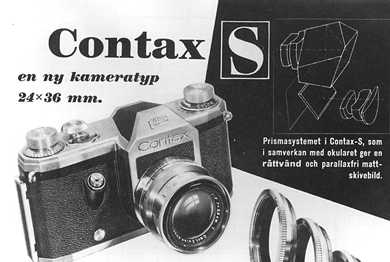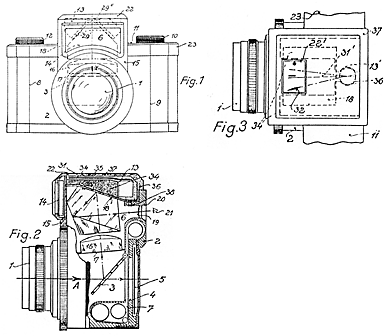By Peter Hennig
The birth of the modern SLR The development of the single lens reflex camera (SLR) with a pentagonal viewing prism, was without doubt the biggest success in camera technology. It is now more than sixty years since the idea was given its concrete form.
By Peter Hennig

Looking through the viewfinder of an SLR for the first time is often a moment of truth. It seems obvious that this is how a camera should be constructed - a camera where you can see exactly what kind of image your lens is going to produce on the film.
It was the clarity of the idea that inspired German architect Kurt Staudinger when he applied for a second class patent on an SLR camera with a pentagonal prism in 1932.
Unrewarding technology
During the 1930s Staudinger travelled around Germany visiting all the camera manufacturers in an ultimately fruitless attempt to convince them that an SLR with a viewing prism was the camera of the future. None of them could be persuaded to act. Although the idea received great interest and praise, no one dared to invest.
It is not hard to understand the manufacturers' reluctance. They did not have the right sort of glass that would ensure that the prism would be bright enough, and on top of that the aperture had to be stopped down just before the exposure, with the consequence that it was nearly impossible to see anything. It compared all too unfavourably with the bright, clear image in a view finder camera that could be quickly focused using an optical rangefinder. There was no real money in such a project.
In fact, Staudinger's camera would not be built until after his patent had expired. A prophet is never accepted in his own country.
From idea to prototype
The strength of the idea of a reflex camera with a viewing prism haunted the camera manufacturers. At many companies it lived on, especially at Zeiss Ikon in Dresden. As early as 1938 a wooden model of an SLR with a pentagonal prism was sitting on the desk of the head designer, Hubert Nerwin. It was a high priority project, but the outbreak of World War II the following year forced them to rein in their ambitions. The German authorities ordered that new civilian projects were to be dispensed with, but work on the camera continued discretely with the approval of the company management. Under difficult conditions, with only lunch breaks and spare time available to them, Nerwin and his staff managed to develop their SLR as far as a full production model. The patent was registered in 1941. In a 1943 interview for a photography magazine, the Zeiss Ikon management said: 'We have developed new and interesting products, but they will have to wait until the war is over.' They were still blithely ignorant of the fact that the end of the war would bring the near total destruction of the company.
The missing prototype
As part of the work that led up to the patent it was necessary to conduct practical tests on different versions of the prism. A couple of Contax II cameras were rebuilt, and the rangefinders replaced with a mount that allowed them to change prisms easily. Both cameras disappeared when Soviet troops occupied Dresden in the spring of 1945, but one of them was to resurface spectacularly in the autumn of the same year in the hands of a Soviet soldier. He complained loudly about the broken prototype, and demanded that it be repaired immediately. The technician who dealt with him did not have the presence of mind simply to replace it with another camera, and instead repaired it. Since then neither of the prototypes has been seen again.
Götterdämmerung
In February 1945, when to all intents and purposes the war had been won by the Allies, Dresden was bombed. The ensuing firestorm destroyed not only one of Europe's richest cultural centres, but also most of the German camera industry.
The situation at Zeiss Ikon, which held the camera of the future in embryonic form, the situation was desperate. How would they ever be able to produce cameras again? Germany had been bombed beyond recognition and divided into occupation zones, nothing worked, the Mark had collapsed, and German patents were invalid. Most of the Zeiss factory premises came under Soviet military administration. There was no end to the list of problems ahead of the surviving company management.
Eggs in different baskets
With brutal logic, the Soviet military government had seized and removed the entire factory where the high status cameras of the day - the Contax II and III - were produced, and set the tone between conqueror and conquered. The best choice now seemed to be to restart production in the relatively undamaged Stuttgart factory in the American zone. This job fell to Hubert Nerwin, who was also instructed to develop new models of the viewfinder Contax camera. Finding competent staff proved difficult as most were dead or missing. A young engineer based in Dresden, Wilhelm Wizenburg, was given the responsibility of developing the 1941 patent into a finished prism-equipped Contax SLR. The work that followed was amongst the strangest in the history of the camera. In just a few years, in a land that had been brought to its knees where you had to bribe your way to obtain the smallest component and screws were a hard currency, the camera of the future was born. The first of these SLRs, the Contax S, was shown unofficially at the St. Erik fair in Stockholm the autumn of 1948. It was officially presented a year later at the Leipzig fair.
Completed and lost
The division of Germany also brought with it the division of Zeiss. The Contax S was officially unveiled in the same year as the DDR was founded. Its development into a finished camera was the result of the spirit of innovation within the Zeiss Ikon company, but it its entire production history is East German, as it was made by VEB Zeiss Ikon, the part of Zeiss Ikon seized by the East German government. Few camera designs have had such a remarkable beginning, and none have been so successful. Millions upon millions of this type of camera have been produced. The pentaprism SLR and its widespread popularity still stand as a reminder of the power of German engineering.

The blueprint of the 1941 patent for a pentaprism Contax SLR with a coupled exposure meter and metal shutter. The final production model was simpler because of the difficult circumstances.
